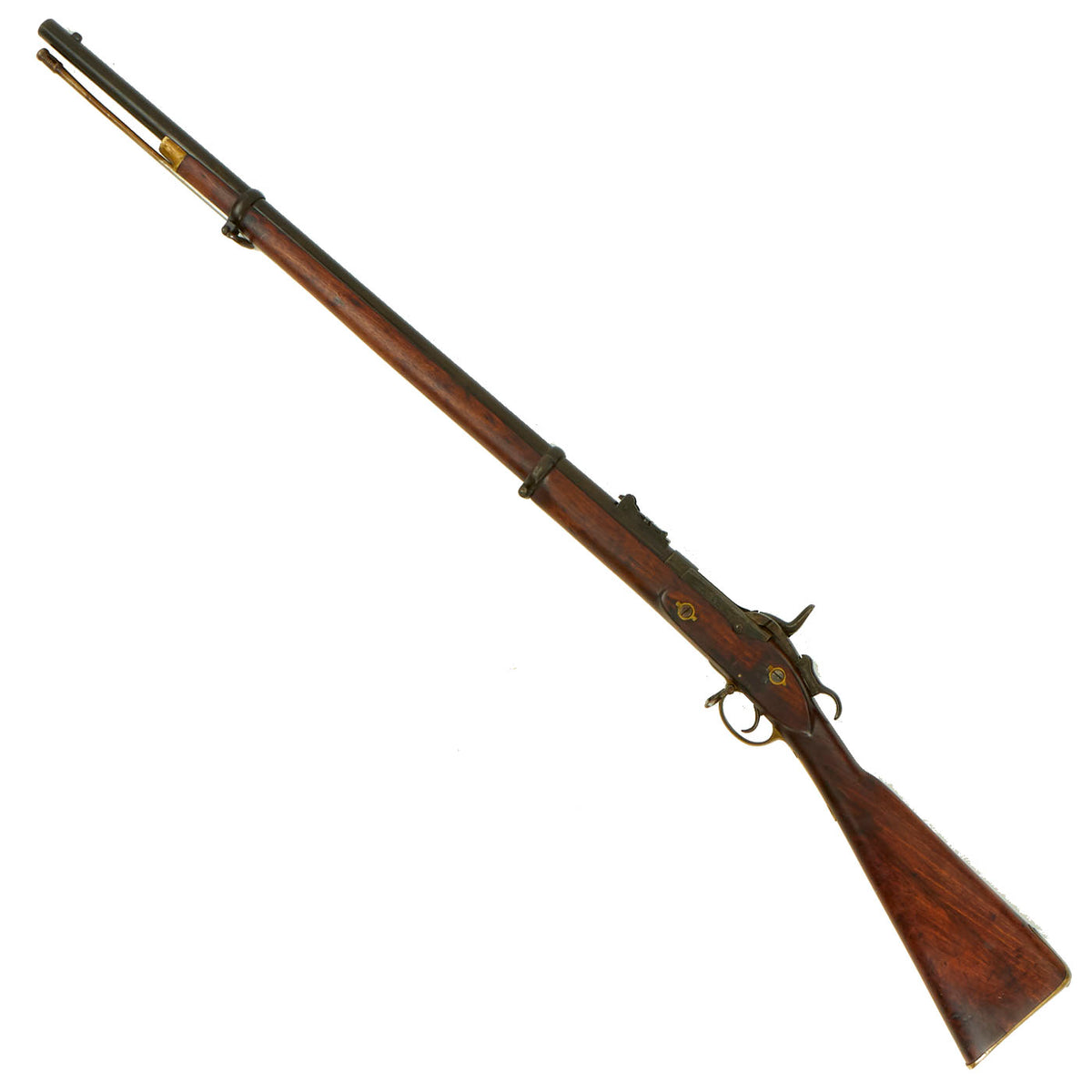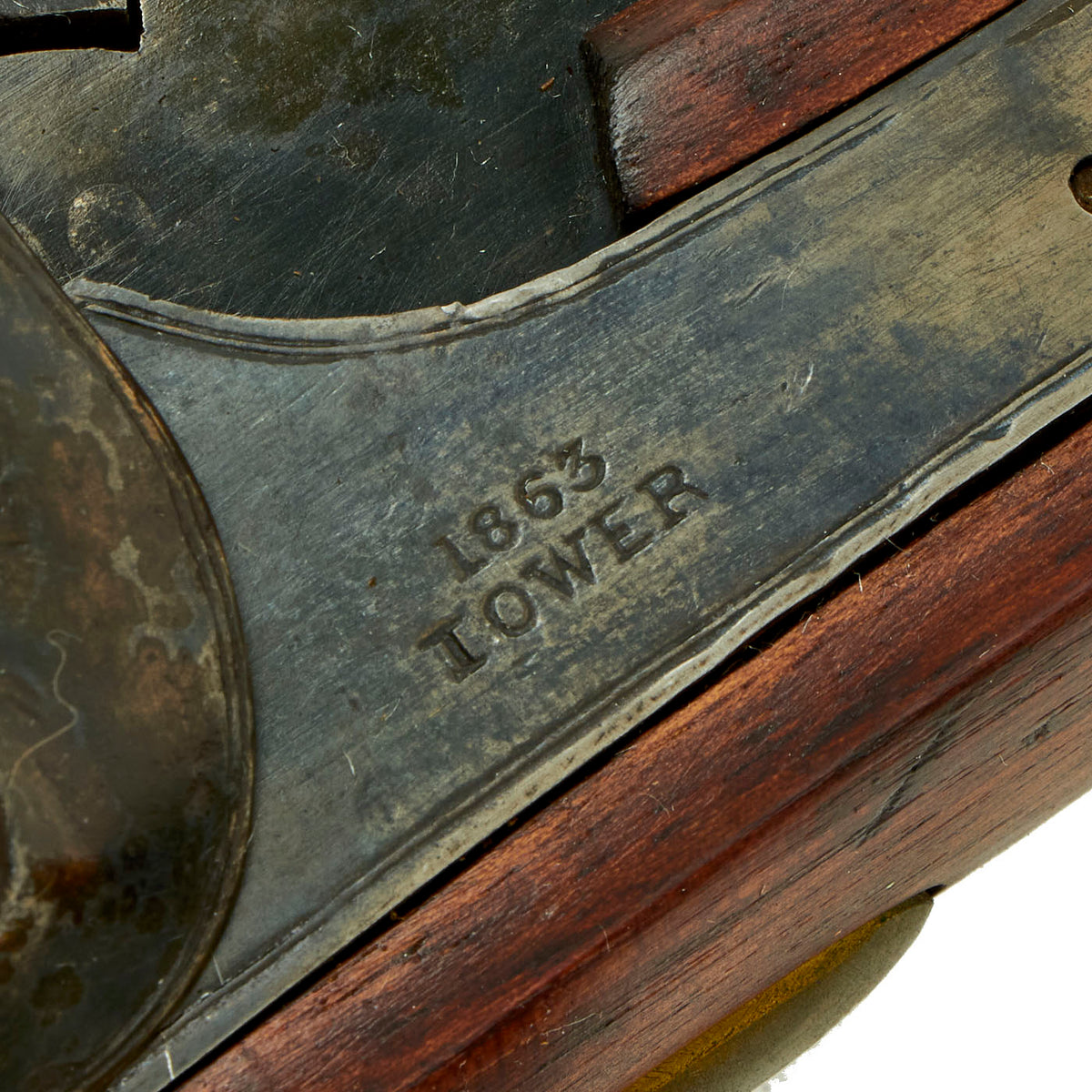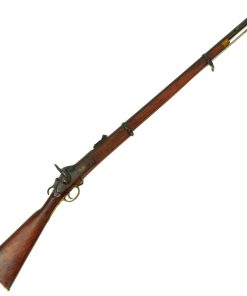Original British Enfield Two Band Short Rifle Converted Robert’s Patent 1867 Breechloader – dated 1863 Original Items
$ 1.395,00 $ 348,75
Original Item: Only One Available. This is very interesting, and certainly something that we have not had before! While we have had two examples of the rare Springfield Model 1863 Robert’s Patent 1867 conversions, we have never had a British Enfield Rifled musket converted in a similar fashion. In the late 1860s like the United States, the British were looking for ways to move to a breech-loading system, and hopefully one that could be used to convert previously made “Rifled Muskets” to the same configuration.
The design that was settled on became the Pattern 1866 Snider-Enfield rifle, based on the design by American Jacob Snider. However, the development and improvements to the design took several years, during which time other competing designs attempted to catch the attention of the British Military. This converted example started life in 1863 as a .577 caliber two band ENFIELD Percussion Short Rifle model of P-1856. The lock is plate stamped with a “CROWN” on the tail and 1863 / ENFIELD, indicating manufacture at the Royal Small Arms factory at Enfield. Of note is that there is no “V.R.” monogram or lock viewer’s marking, so this rifle was made for the private market, and not a military issued example. These would have been easily obtainable for the purpose of trials.
The Robert’s Patent 1867 system is actually a type of “falling-block” action, similar to the Martini-Henry. The breech is accessed by raising a lever behind the tang that can only be fully opened with the hammer in the fired position. This drops the breech block into the stock, allowing a cartridge to be inserted from the rear. The action is then closed and locked, and the rifle can then be cocked and fired. Patent marking ROBERT’S PAT. / JUNE.11.1867 is visible on the left hand side of the receiver.
The whole rifle is in very good collector’s condition, with a lovely glow to the wooden stock. It does show repairs, and definitely some damage from service ,especially on the left side by the lock screws. The barrel has standard three grove rifling and the bore shows clear lands and grooves, though the bore is somewhat dark from fouling and oxidation. The metalwork has a lovely worn blued finish, and the rifle still has the original cleaning rod and both sling swivels present. The breech functions correctly, and the lock properly holds at half cock, firing at full. We did notice that the receiver tang screw is not present, but it does not seem to affect the stability for display purposes.
A very rare and interesting Robert’s Patent 1867 Breechloading rifle, originally made at ENFIELD. In lovely condition and ready to display!
Specifications:
Year of Manufacture: 1863 – Converted Later
Caliber: .58 inches
Ammunition Type: .577 Centerfire Cartridge
Barrel Length: 30.75 inches
Overall Length: 50 inches
Action: Side Action Lock
Feed System: Trapdoor Breech Single Shot
More on the P-1853 Rifle-Musket: The Enfield Pattern 1853 rifle-musket (also known as the Pattern 1853 Enfield, P53 Enfield, and Enfield rifle-musket) was a .577 calibre Minié-type muzzle-loading rifle-musket, used by the British Empire from 1853 to 1867, after which many Enfield 1853 rifle-muskets were converted to (and replaced in service by) the cartridge-loaded Snider-Enfield rifle.
The term “rifle-musket” originally referred to muskets with the smooth-bored barrels replaced with rifled barrels. The length of the barrels were unchanged, allowing the weapons to be fired by rank, since a long rifle was necessary to enable the muzzles of the second rank of soldiers to project beyond the faces of the men in front. The weapon would also be sufficiently long when fitted with a bayonet to be effective against cavalry. Such guns manufactured with rifled barrels, muzzle loading, single shot, and utilizing the same firing mechanism, also came to be called rifle-muskets.
The 39 in (99 cm) barrel had three grooves, with a 1:78 rifling twist, and was fastened to the stock with three metal bands, so that the rifle was often called a “three band” model. After several years, the Pattern 1856 Short Rifle was designed as the Pattern 1856, and various other models came afterwards to fill various different needs.
NOTE: International orders of antique firearms MUST be shipped using UPS WW Services (courier). USPS Priority Mail international will not accept these. International customers should always consult their country’s antique gun laws prior to ordering.
Fast Shipping with Professional Packaging
Thanks to our longstanding association with UPS FedEx DHL, and other major international carriers, we are able to provide a range of shipping options. Our warehouse staff is expertly trained and will wrap your products according to our exact and precise specifications. Prior to shipping, your goods will be thoroughly examined and securely secured. We ship to thousands clients each day across multiple countries. This shows how we're dedicated to be the largest retailer on the internet. Warehouses and distribution centres can be located throughout Europe as well as the USA.
Note: Orders with more than one item will be assigned a processing date depending on the item.
Before shipping before shipping, we'll conduct a thorough inspection of the items you have ordered. Today, the majority of orders will be delivered within 48 hours. The delivery time will be between 3-7 days.
Returns
The stock is dynamic and we cannot completely manage it because multiple stakeholders are involved, including our factory and warehouse. So the actual stock may alter at any time. It's possible that you may not receive your order once the order has been made.
Our policy is valid for a period of 30 days. If you don't receive the product within 30 days, we are not able to issue a refund or an exchange.
You can only return an item if it is unused and in the same state as the day you received it. You must have the item in its original packaging.
Related products
Uncategorized
Australian WWII Owen MK1 Machine Carbine SMG Custom Fabricated Replica with Sling Original Items
Uncategorized
Uncategorized
Uncategorized
Uncategorized
Uncategorized
Uncategorized
Uncategorized
Uncategorized
Uncategorized
Uncategorized
Uncategorized
Uncategorized
Uncategorized
Uncategorized
Uncategorized
Angolan Rebel 1970s era 60mm Inert Display Mortar from Angolan Civil War Original Items













































































